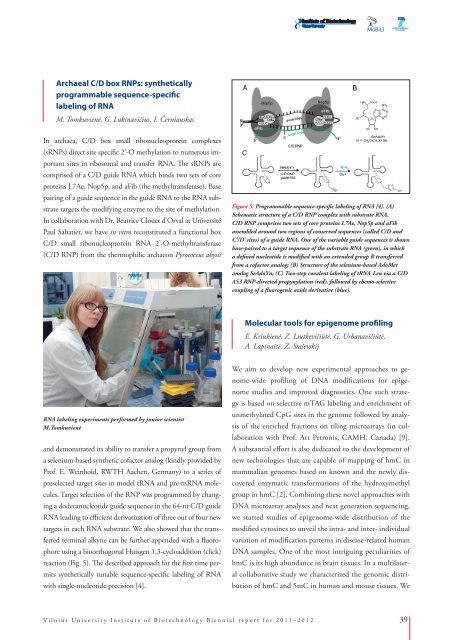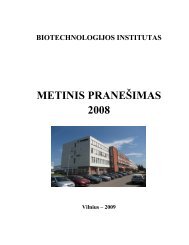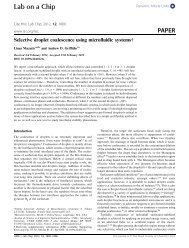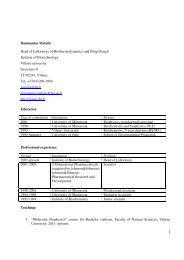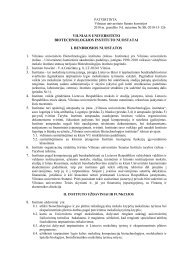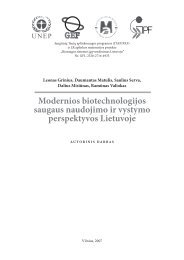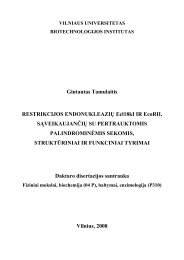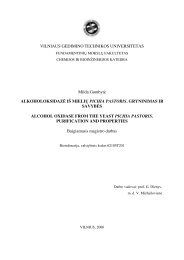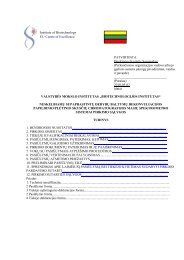Biennial Report 2011â2012
Biennial Report 2011â2012
Biennial Report 2011â2012
You also want an ePaper? Increase the reach of your titles
YUMPU automatically turns print PDFs into web optimized ePapers that Google loves.
Archaeal C/D box RNPs: synthetically<br />
programmable sequence-specific<br />
labeling of RNA<br />
M. Tomkuvienė, G. Lukinavičius, I. Černiauskas<br />
In archaea, C/D box small ribonucleoprotein complexes<br />
(sRNPs) direct site specific 2’-O methylation to numerous important<br />
sites in ribosomal and transfer RNA. The sRNPs are<br />
comprised of a C/D guide RNA which binds two sets of core<br />
proteins L7Ae, Nop5p, and aFib (the methyltransferase). Base<br />
pairing of a guide sequence in the guide RNA to the RNA substrate<br />
targets the modifying enzyme to the site of methylation.<br />
In collaboration with Dr. Beatrice Clouet d’Orval at Université<br />
Paul Sabatier, we have in vitro reconstituted a functional box<br />
C/D small ribonucleoprotein RNA 2’-O-methyltransferase<br />
(C/D RNP) from the thermophilic archaeon Pyrococcus abyssi<br />
Figure 5. Programmable sequence-specific labeling of RNA [4]. (A)<br />
Schematic structure of a C/D RNP complex with substrate RNA.<br />
C/D RNP comprises two sets of core proteins L7Ae, Nop5p and aFib<br />
assembled around two regions of conserved sequences (called C/D and<br />
C’/D’ sites) of a guide RNA. One of the variable guide sequences is shown<br />
base-paired to a target sequence of the substrate RNA (green), in which<br />
a defined nucleotide is modified with an extended group R transferred<br />
from a cofactor analog; (B) Structure of the selenium-based AdoMet<br />
analog SeAdoYn; (C) Two-step covalent labeling of tRNA-Leu via a C/D<br />
A53 RNP-directed propynylation (red), followed by chemo-selective<br />
coupling of a fluorogenic azide derivative (blue).<br />
Molecular tools for epigenome profiling<br />
E. Kriukienė, Z. Liutkevičiūtė, G. Urbanavičiūtė,<br />
A. Lapinaitė, Z. Staševskij<br />
RNA labeling experiments performed by junior scientist<br />
M.Tomkuvienė<br />
and demonstrated its ability to transfer a propynyl group from<br />
a selenium-based synthetic cofactor analog (kindly provided by<br />
Prof. E. Weinhold, RWTH Aachen, Germany) to a series of<br />
preselected target sites in model tRNA and pre-mRNA molecules.<br />
Target selection of the RNP was programmed by changing<br />
a dodecanucleotide guide sequence in the 64-nt C/D guide<br />
RNA leading to efficient derivatization of three out of four new<br />
targets in each RNA substrate. We also showed that the transferred<br />
terminal alkyne can be further appended with a fluorophore<br />
using a bioorthogonal Huisgen 1,3-cycloaddition (click)<br />
reaction (Fig. 5). The described approach for the first time permits<br />
synthetically tunable sequence-specific labeling of RNA<br />
with single-nucleotide precision [4].<br />
We aim to develop new experimental approaches to genome-wide<br />
profiling of DNA modifications for epigenome<br />
studies and improved diagnostics. One such strategy<br />
is based on selective mTAG labeling and enrichment of<br />
unmethylated CpG sites in the genome followed by analysis<br />
of the enriched fractions on tiling microarrays (in collaboration<br />
with Prof. Art Petronis, CAMH, Canada) [9].<br />
A substantial effort is also dedicated to the development of<br />
new technologies that are capable of mapping of hmC in<br />
mammalian genomes based on known and the newly discovered<br />
enzymatic transformations of the hydroxymethyl<br />
group in hmC [2]. Combining these novel approaches with<br />
DNA microarray analyses and next generation sequencing,<br />
we started studies of epigenome-wide distribution of the<br />
modified cytosines to unveil the intra- and inter- individual<br />
variation of modification patterns in disease-related human<br />
DNA samples. One of the most intriguing peculiarities of<br />
hmC is its high abundance in brain tissues. In a multilateral<br />
collaborative study we characterized the genomic distribution<br />
of hmC and 5mC in human and mouse tissues. We<br />
Vilnius University Institute of Biotechnology <strong>Biennial</strong> report for 2011–2012 39


